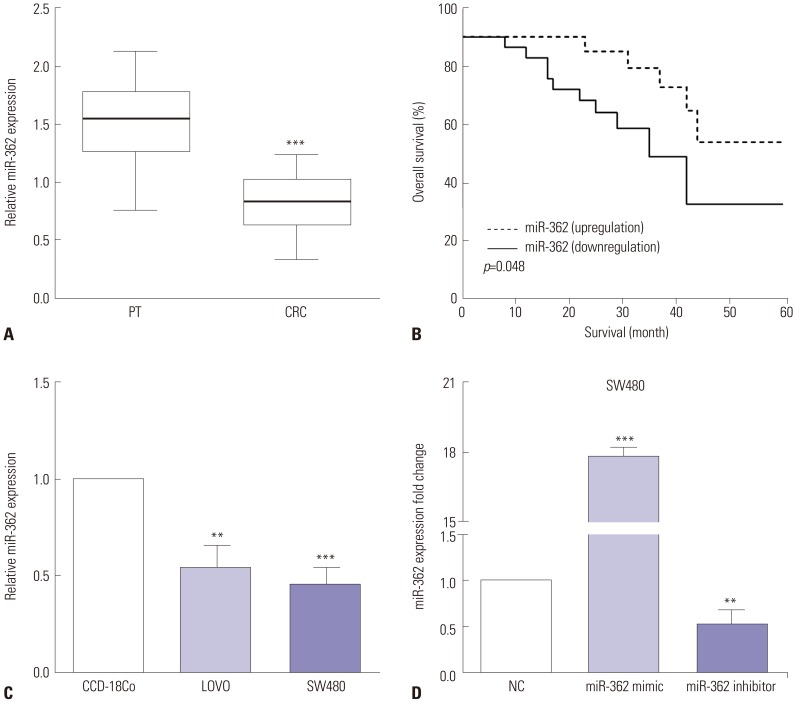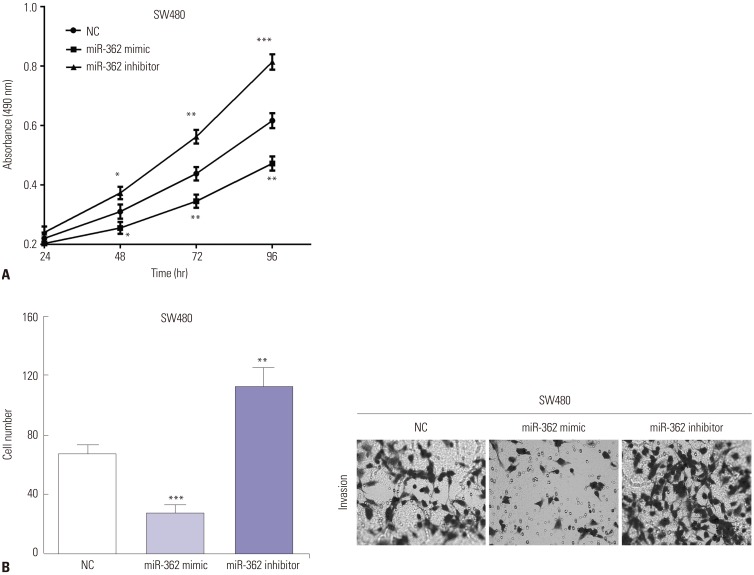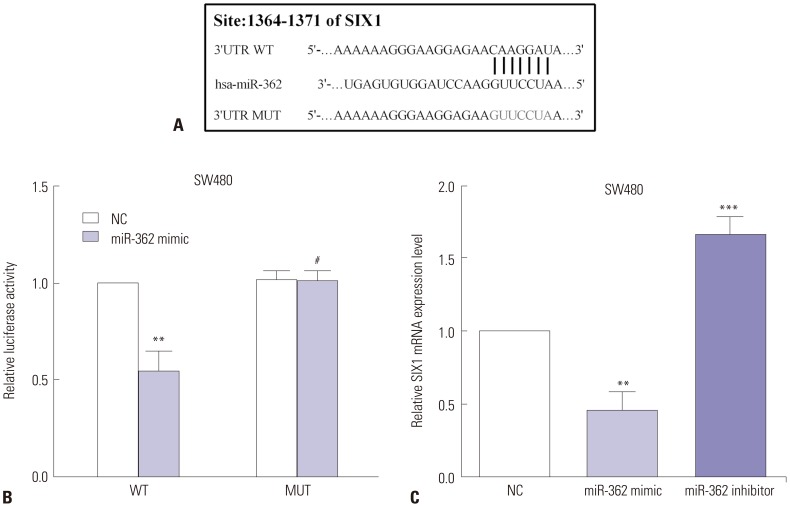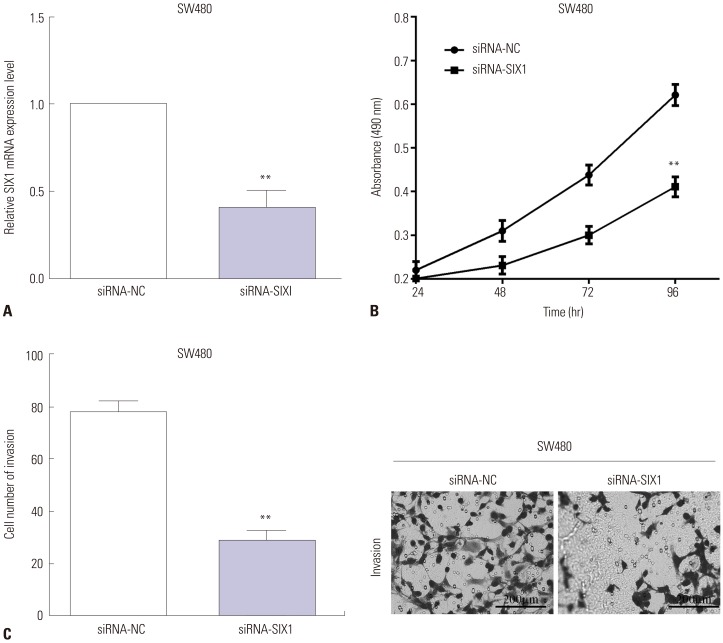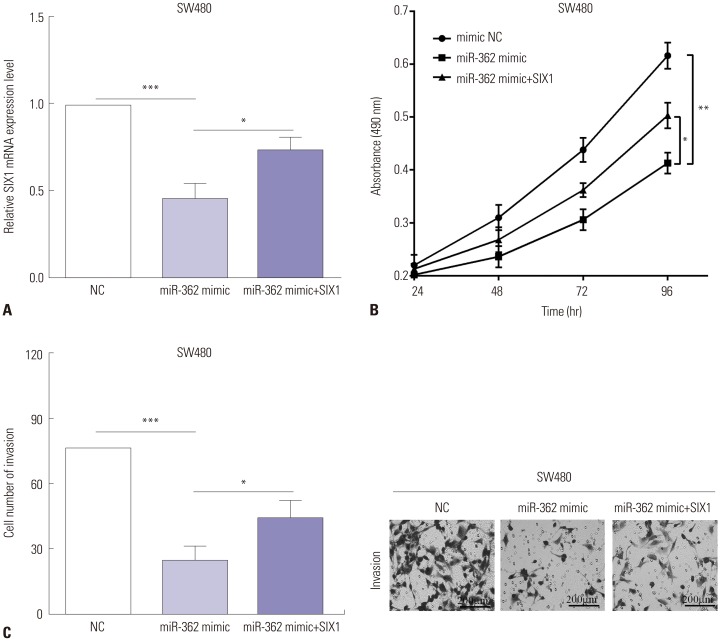Yonsei Med J.
2019 May;60(5):414-422. 10.3349/ymj.2019.60.5.414.
MicroRNA-362 Inhibits Cell Proliferation and Invasion by Directly Targeting SIX1 in Colorectal Cancer
- Affiliations
-
- 1Department of Hyperbaric Oxygen, The Affiliated Hospital of Qingdao University, Qingdao, China.
- 2Department of Oncology, Zouping Centre Hospital, Binzhou, China.
- 3Department of Anorectal Surgery, The Affiliated Hospital of Qingdao University, Qingdao, China. ttrsog32694329@163.com
- KMID: 2443244
- DOI: http://doi.org/10.3349/ymj.2019.60.5.414
Abstract
- PURPOSE
Colorectal cancer (CRC) is the third most common cancer in China and poses high morbidity and mortality. In recent years, increasing evidence has indicated that microRNAs played important functions in the occurrence and development of tumors. The purpose of this study was to identify the biological mechanisms of miR-362 in CRC.
MATERIALS AND METHODS
Quantitative real-time PCR was carried out to assess the expression of miR-362 and SIX1. The Kaplan-Meier method was employed to evaluate the 5-year overall survival of CRC patients. The proliferative and invasive abilities of CRC cells were assessed by MTT and transwell assays.
RESULTS
miR-362 was significantly decreased in CRC tissues and cell lines, compared to the normal tissues and normal cells. A significant connection was confirmed between the overall survival of 53 CRC patients and low expression of miR-362. Downregulation of miR-362 inhibited the proliferation and invasion through binding to the 3"²-UTR of SIX1 mRNA in CRC. Additionally, we discovered that SIX1 was a direct target gene of miR-362 and that the expression of miR-362 had a negative connection with SIX1 expression in CRC. SIX1 could reverse partial functions in the proliferation and invasion in CRC cells.
CONCLUSION
miR-362 may be a prognostic marker in CRC and suppress CRC cell proliferation and invasion in part through targeting the 3"²-UTR of SIX1 mRNA. The newly identified miR-362/SIX1 axis provides insight into the progression of CRC.
Keyword
MeSH Terms
Figure
Reference
-
1. Brenner H, Kloor M, Pox CP. Colorectal cancer. Lancet. 2014; 383:1490–1502. PMID: 24225001.
Article2. Torre LA, Bray F, Siegel RL, Ferlay J, Lortet-Tieulent J, Jemal A. Global cancer statistics, 2012. CA Cancer J Clin. 2015; 65:87–108. PMID: 25651787.
Article3. Shimada H, Tanaka K, Endou I, Ichikawa Y. Treatment for colorectal liver metastases: a review. Langenbecks Arch Surg. 2009; 394:973–983. PMID: 19582473.
Article4. Kalluri R, Weinberg RA. The basics of epithelial-mesenchymal transition. J Clin Invest. 2009; 119:1420–1428. PMID: 19487818.
Article6. Ju J. Implications of miRNAs in colorectal cancer chemoresistance. Int Drug Discov. 2011; 2011:2063. PMID: 25750759.7. Ke SB, Qiu H, Chen JM, Shi W, Chen YS. MicroRNA-202-5p functions as a tumor suppressor in colorectal carcinoma by directly targeting SMARCC1. Gene. 2018; 676:329–335. PMID: 30144500.
Article8. Chen E, Li Q, Wang H, Zhang P, Zhao X, Yang F, et al. MiR-32 promotes tumorigenesis of colorectal cancer by targeting BMP5. Biomed Pharmacother. 2018; 106:1046–1051. PMID: 30119170.
Article9. Wang D, Wang H, Li Y, Li Q. MiR-362-3p functions as a tumor suppressor through targeting MCM5 in cervical adenocarcinoma. Biosci Rep. 2018; 38:BSR20180668. PMID: 29871972.
Article10. Yang P, Ni F, Deng RQ, Qiang G, Zhao H, Yang MZ, et al. MiR-362-5p promotes the malignancy of chronic myelocytic leukaemia via down-regulation of GADD45α. Mol Cancer. 2015; 14:190. PMID: 26545365.
Article11. Xia JT, Chen LZ, Jian WH, Wang KB, Yang YZ, He WL, et al. MicroRNA-362 induces cell proliferation and apoptosis resistance in gastric cancer by activation of NF-κB signaling. J Transl Med. 2014; 12:33. PMID: 24495516.
Article12. Wang N, Feng Y, Xu J, Zou J, Chen M, He Y, et al. miR-362-3p regulates cell proliferation, migration and invasion of trophoblastic cells under hypoxia through targeting Pax3. Biomed Pharmacother. 2018; 99:462–468. PMID: 29665647.
Article13. Christensen LL, Tobiasen H, Holm A, Schepeler T, Ostenfeld MS, Thorsen K, et al. MiRNA-362-3p induces cell cycle arrest through targeting of E2F1, USF2 and PTPN1 and is associated with recurrence of colorectal cancer. Int J Cancer. 2013; 133:67–78. PMID: 23280316.
Article14. Christensen KL, Patrick AN, McCoy EL, Ford HL. The six family of homeobox genes in development and cancer. Adv Cancer Res. 2008; 101:93–126. PMID: 19055944.15. Kumar JP. The sine oculis homeobox (SIX) family of transcription factors as regulators of development and disease. Cell Mol Life Sci. 2009; 66:565–583. PMID: 18989625.
Article16. Wu W, Ren Z, Liu H, Wang L, Huang R, Chen J, et al. Core promoter analysis of porcine Six1 gene and its regulation of the promoter activity by CpG methylation. Gene. 2013; 529:238–244. PMID: 23954877.
Article17. Micalizzi DS, Wang CA, Farabaugh SM, Schiemann WP, Ford HL. Homeoprotein Six1 increases TGF-beta type I receptor and converts TGF-beta signaling from suppressive to supportive for tumor growth. Cancer Res. 2010; 70:10371–10380. PMID: 21056993.18. Cheng Q, Ning D, Chen J, Li X, Chen XP, Jiang L. SIX1 and DACH1 influence the proliferation and apoptosis of hepatocellular carcinoma through regulating p53. Cancer Biol Ther. 2018; 19:381–390. PMID: 29333942.
Article19. Xin X, Li Y, Yang X. SIX1 is overexpressed in endometrial carcinoma and promotes the malignant behavior of cancer cells through ERK and AKT signaling. Oncol Lett. 2016; 12:3435–3440. PMID: 27900017.
Article20. Lerbs T, Bisht S, Schölch S, Pecqueux M, Kristiansen G, Schneider M, et al. Inhibition of Six1 affects tumour invasion and the expression of cancer stem cell markers in pancreatic cancer. BMC Cancer. 2017; 17:249. PMID: 28388884.
Article21. Zhang X, Xu R. Six1 expression is associated with a poor prognosis in patients with glioma. Oncol Lett. 2017; 13:1293–1298. PMID: 28454249.
Article22. Bray F, Ferlay J, Soerjomataram I, Siegel RL, Torre LA, Jemal A. Global cancer statistics 2018: GLOBOCAN estimates of incidence and mortality worldwide for 36 cancers in 185 countries. CA Cancer J Clin. 2018; 68:394–424. PMID: 30207593.
Article23. Chen W, Zheng R, Baade PD, Zhang S, Zeng H, Bray F, et al. Cancer statistics in China, 2015. CA Cancer J Clin. 2016; 66:115–132. PMID: 26808342.
Article24. Lu J, Getz G, Miska EA, Alvarez-Saavedra E, Lamb J, Peck D, et al. MicroRNA expression profiles classify human cancers. Nature. 2005; 435:834–838. PMID: 15944708.
Article25. Volinia S, Calin GA, Liu CG, Ambs S, Cimmino A, Petrocca F, et al. A microRNA expression signature of human solid tumors defines cancer gene targets. Proc Natl Acad Sci U S A. 2006; 103:2257–2261. PMID: 16461460.
Article26. Zou X, Zhong J, Li J, Su Z, Chen Y, Deng W, et al. miR-362-3p targets nemo-like kinase and functions as a tumor suppressor in renal cancer cells. Mol Med Rep. 2016; 13:994–1002. PMID: 26647877.
Article27. Wu K, Yang L, Chen J, Zhao H, Wang J, Xu S, et al. miR-362-5p inhibits proliferation and migration of neuroblastoma cells by targeting phosphatidylinositol 3-kinase-C2β. FEBS Lett. 2015; 589:1911–1919. PMID: 26073258.
Article28. Kheirollahi M, Moodi M, Ashouri S, Nikpour P, Kazemi M. Evaluation of miR-362 expression in astrocytoma of human brain tumors. Adv Biomed Res. 2017; 6:129. PMID: 29142892.
Article29. Ni F, Gui Z, Guo Q, Hu Z, Wang X, Chen D, et al. Downregulation of miR-362-5p inhibits proliferation, migration and invasion of human breast cancer MCF7 cells. Oncol Lett. 2016; 11:1155–1160. PMID: 26893711.
Article30. Hua L, Fan L, Aichun W, Yongjin Z, Qingqing C, Xiaojian W. Inhibition of Six1 promotes apoptosis, suppresses proliferation, and migration of osteosarcoma cells. Tumour Biol. 2014; 35:1925–1931. PMID: 24114014.
Article31. Yu C, Zhang B, Li YL, Yu XR. SIX1 reduces the expression of PTEN via activating PI3K/AKT signal to promote cell proliferation and tumorigenesis in osteosarcoma. Biomed Pharmacother. 2018; 105:10–17. PMID: 29807230.
Article32. Sun SH, Liu D, Deng YT, Zhang XX, Wan DY, Xi BX, et al. SIX1 coordinates with TGFβ signals to induce epithelial-mesenchymal transition in cervical cancer. Oncol Lett. 2016; 12:1271–1278. PMID: 27446426.
Article33. Jin A, Xu Y, Liu S, Jin T, Li Z, Jin H, et al. Sineoculis homeobox homolog 1 protein overexpression as an independent biomarker for pancreatic ductal adenocarcinoma. Exp Mol Pathol. 2014; 96:54–60. PMID: 24263054.
Article34. Lv H, Cui A, Sun F, Zhang Y, Li Y, Li L, et al. Sineoculis homeobox homolog 1 protein as an independent biomarker for gastric adenocarcinoma. Exp Mol Pathol. 2014; 97:74–80. PMID: 24866365.
Article35. Kong J, Zhou X, Liu S, Jin T, Piao Y, Liu C, et al. Overexpression of sineoculis homeobox homolog 1 predicts poor prognosis of hepatocellular carcinoma. Int J Clin Exp Pathol. 2014; 7:3018–3027. PMID: 25031720.36. He Z, Li G, Tang L, Li Y. SIX1 overexpression predicts poor prognosis and induces radioresistance through AKT signaling in esophageal squamous cell carcinoma. Onco Targets Ther. 2017; 10:1071–1079. PMID: 28260921.
Article37. Xia Y, Zhu Y, Ma T, Pan C, Wang J, He Z, et al. miR-204 functions as a tumor suppressor by regulating SIX1 in NSCLC. FEBS Lett. 2014; 588:3703–3712. PMID: 25157435.
Article38. O'Brien JH, Hernandez-Lagunas L, Artinger KB, Ford HL. MicroRNA-30a regulates zebrafish myogenesis through targeting the transcription factor Six1. J Cell Sci. 2014; 127(Pt 10):2291–2301. PMID: 24634509.
- Full Text Links
- Actions
-
Cited
- CITED
-
- Close
- Share
- Similar articles
-
- MicroRNA-98-5p Inhibits Tumorigenesis of Hepatitis B Virus-Related Hepatocellular Carcinoma by Targeting NF-κB-Inducing Kinase
- Up-Regulation of MiR-1915 Inhibits Proliferation, Invasion, and Migration of Helicobacter pylori-Infected Gastric Cancer Cells via Targeting RAGE
- miR-379 Inhibits Cell Proliferation, Invasion, and Migration of Vascular Smooth Muscle Cells by Targeting Insulin-Like Factor-1
- MicroRNA-373 Inhibits Cell Proliferation and Invasion via Targeting BRF2 in Human Non-small Cell Lung Cancer A549 Cell Line
- The MicroRNA hsa-let-7g Promotes Proliferation and Inhibits Apoptosis in Lung Cancer by Targeting HOXB1

